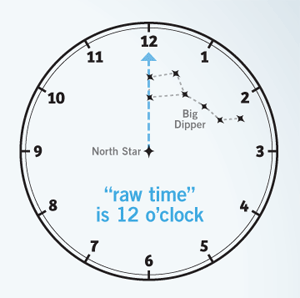Telling Time with the Stars
Genesis 1:14 says God made lights in the heavens “for signs and for seasons.” With a little practice it’s possible to know the time of night, just by looking at the stars.
In past generations, telling time by the stars was an essential part of life.
On the first Wednesday, God created lights in the heavens: the sun, moon, and stars. One of the primary purposes was to mark the passage of time. These lights were for “signs and for seasons and for days and years” (Genesis 1:14). In past generations, telling time by the stars was an essential part of life. In our modern society, where wristwatches and cell phones are everywhere, this has become a lost art.
But it is really pretty easy to do. You can even roughly estimate the time by eye, as long as you don’t need high precision.
The sun is the primary object we use to tell time. The time is roughly noon when the sun reaches its highest point in the sky. The sun will appear directly south of overhead if you live north of the tropics. (The time can be a bit off from noon depending on where you live within your time zone. Also, you need to add one hour during daylight savings time. But this method works well to make a rough estimate.)
Telling time by the stars has many similarities (and challenges). Like the sun, stars rise in the east and set in the west. So if you see a star rise due east, it will reach its highest point in the sky six hours later and will set six hours after that. A good example to look for is Orion, visible during mid-winter. During early January, this constellation rises due east around 6:00 p.m. and sinks to the west at 6:00 a.m.
The key to finding stars and constellations is the North Star. The constellations all seem to “spin” around the North Star every night, like the hour hand on a clock. Unlike man-made 12-hour clocks, the star clock takes a bit less than 24 hours to make a complete circuit. So when you pay attention to the location of the constellations relative to the North Star at the beginning of the night, you can estimate the time just from watching the movement of the stars over the course of the night.
“Losing” Two Hours Per Month
The earth’s orbit around the sun has an interesting effect on the location of the stars. It changes from night to night. If you were to go outside every evening at a particular time, say 10:00 p.m., you would notice that the stars have shifted slightly to the west from where they were the previous evening at that time. The earth’s motion around the sun has caused a slight change in our perspective. For this reason, each night stars rise roughly four minutes earlier than they did the previous night. (This is why it takes slightly less than 24 hours for the stars to make a complete cycle.)
For example, suppose you see a bright star rise at 11:30 p.m. on January 1. The next night, that same star will rise at 11:26 p.m. After one week, on January 8, that same star will rise about a half hour earlier (around 11:00 p.m.) than it did the previous week.
This effect adds up and means that stars rise two hours earlier per month.
So the star that you saw rise at 11:30 p.m. on January 1 will rise at 9:30 p.m. on February 1. This explains why the constellations look different in the winter evening sky than they do in the summer evening sky.
Constellations that appear in the summer evening are found in the morning sky during winter. After one year, the stars are back to their original position—they rise at the same time they did one year earlier.
The next time you are out on a clear night, look up and notice where the stars are. And remember to thank God for the consistent and clockwork precision with which He upholds His universe.
See for Yourself . . .

To tell time by the stars, follow five simple steps. Don’t be intimidated—it gets easy with practice.
- Find the Big Dipper and North Star. Locate the two stars in the outside dip of the Big Dipper. They point towards the North Star (the tip of the Little Dipper’s handle). Calculate the approximate “raw time.” This is a raw number, not the final number.
For example, suppose on December 7 you find the two pointer stars pointing due north. The “raw time” is 12 o’clock. - If the month is before March 7, subtract 1 hour per month.
If the month is after March 7, add 1 hour per month. (You can
get even more precise times if you include parts of a month.)
For example, if the “raw time” on December 7 is 12 o’clock, subtract 3 (for 3 months) to get 9 o’clock. - Double the time. The star clock completes one circuit in 24 hours, not 12 hours
like a normal clock. So double your “raw time.”
For example, double 9 o’clock to get 18. - Subtract from 24. The 24-hour star clock runs counterclockwise, unlike a normal clock. So you need to account for this.
In the example above, subtract 18 from 24 to get 6. The real time is 6 p.m. - Add one hour if you are on Daylight Savings Time. DST now runs from March to
November in the U.S. and Canada. (To be even more accurate, add or subtract up
to 30 minutes, depending on where you are located in your time zone.)
December 7 is not under Daylight Savings Time. So no change is needed. The time is 6 p.m.!
Find the “Raw Time”
Calculate the “Real Time”
Account for Daylight Savings Time
Answers Magazine
January – March 2011
This issue of Answers points a telescope at the heavens. Explore evidences that the universe is young, from blue stars to spiral galaxies. Get up-to-date on the search for extraterrestrial life, and be the first to read Dr. Jason Lisle’s new model explaining distant starlight. You also don’t want to miss articles on living fossils and other wonders of our own planet that point to a recent creation and global Flood.
Browse IssueRecommended Resources

Answers in Genesis is an apologetics ministry, dedicated to helping Christians defend their faith and proclaim the good news of Jesus Christ.
- Customer Service 800.778.3390
- Available Monday–Friday | 9 AM–5 PM ET
- © 2025 Answers in Genesis





